Features
Healing the nation – A question of leadership

Deshamanya Dr P.R. Anthonis Memorial Oration
by Dr Nihal Jayawickrama
I am deeply honoured by the invitation of the Lanka-Japan Friendship Society to deliver the Deshamanya Dr P.R. Anthonis Memorial Lecture this evening. I was intrigued by the subject that was assigned to me, since a surgeon’s approach to healing a patient is usually to cut and remove a part of his or her anatomy. I wondered whether I was expected to advocate the same approach to healing the nation.
Coming, as I do, from a family of lawyers, with only one doctor of medicine produced in several generations, it was my brother who knew and worked with Dr Anthonis over many years. Dr Anthonis was one of a small group of brilliant surgeons of the 20th century that included Dr Noel Bartholomeusz and Dr M.V.P. Peries. I have had the good fortune never to have been subjected to Dr Anthonis’s scalpel, but I have had the privilege of meeting him socially, and he always treated me with the utmost kindness. To the memory of that remarkable surgeon, I dedicate my own thoughts on the subject I propose to address, with respect and affection.
‘Healing the Nation – A question of leadership’ immediately raises the question: what is expected of a political leader in a democratic society? Should the leader reflect the views, the fears and the prejudices of the electorate to which he has to return for re-election; or should he determine a path according to his own vision, his own values and his own judgment, and endeavour to lead his electorate along that path? President Jayewardene ruminated on this issue some years after he had left office and wondered how long one could go along with the wishes of the electorate.
A military leader does not have to worry about that, but a democratic leader must because the electors are his main and only support. It was difficult to be re-elected unless the leader continued to enjoy the support of those who had placed him in that position. However, he was willing to make an exception in regard to economic matters where external factors often determined what could or could not be done, however much that might displease the electorate. Incidentally, he had some sound advice for those aspiring to be leaders. Politics, he said, was a “stayers’ race”; a race where a man or woman who does not try to kick his neighbour or jump over him, but stays on till all the others disappear, wins the race. Therefore, he advised aspirants for political leadership that good health was vital: “look after your kidney, nurse your heart, eat little, don’t exercise too much, and in the end, you win the stayer’s race and you become the leader”.
Not being a politician, and not intending to be one at this stage of my life, I am free to disagree with President Jayewardene. I believe that a leader must possess a vision that he pursues with wisdom and integrity, and it is his responsibility to convince his electorate that he is on the right path. At the height of the American civil war, when things were not going well for the North, Abraham Lincoln was advised that he might need to compromise on slavery. Lincoln held firm on the issue of abolition. More recently, Nelson Mandela’s decision to be magnanimous in victory must have enraged tens of thousands of black Africans who had been subjected to oppression and brutality at the hands of the previous white apartheid regime. Yet, both Lincoln and Mandela achieved peace in their respective countries. That, in my view, was the result of leadership.
To establish the parameters for my presentation, I need to define the expression “healing the nation”. To heal is to mend, to reconcile, to rectify, or to restore. It presupposes that the nation is wounded, hurt, or broken. In this context, “the nation” must mean Ceylon or Sri Lanka. However, about a 100 years ago, Anagarika Dharmapala began writing aggressively of the “Sinhala nation”, and in course of time “Sinhala” became the equivalent of “jathiya” or “Lankika”. In 1944, the Communist Party made the first reference to the “Tamil nation”, a term that was finally affirmed in the Vaddukoddai Resolution of 1976.
In the contemporary world, this is not a matter for any real concern. For over several centuries “English” was synonymous with “British”, but today, the nation known as “Great Britain” comprises at least three nations: the English nation, the Scottish nation, and the Welsh nation. Each has a distinct language, religion and a proud culture. Scotland and Wales have their own legislative assemblies and are represented in Westminster in both the Parliament and the Cabinet. Together with Northern Ireland, these three nations constitute the United Kingdom. Similarly, the nation of Sri Lanka includes the Sinhala nation and the Tamil nation and several other communities, and it is to the break-up of that nation that I now turn.
THE BREAK-UP OF THE NATION
When did the break-up of the Sri Lankan nation occur? I would submit that it was not a single event, but a series of events that led to the nation being wounded, hurt or broken. In the first quarter of the 20th century, all the different ethnic communities stood together as Ceylonese in agitating for constitutional reform. However, with the introduction in 1931 of universal adult franchise, and with impending self-government, it was natural that minority communities would become apprehensive of majority rule. There was cause for this. The Sinhala Maha Sabha, established by S.W.R.D. Bandaranaike in 1937, was already engaged in creating a national consciousness among the Sinhalese. Meanwhile, following the election of the second State Council in 1936, the Sinhalese members, together with the European members, succeeded in electing a Board of Ministers that was exclusively Sinhalese – the so-called “Pan-Sinhalese Board of Ministers”.
The 1946 Constitution
The fears of the minority communities were set at rest by the Soulbury Commission which recommended the inclusion in the constitution of a package of safeguards. These were:Multi-member constituencies in those areas in which a substantial racial or religious minority lived.Six nominated members of the House of Representatives to represent any inadequately represented interests.
The Senate, which would serve the minorities as an instrument for impeding precipitate legislation, as well as a forum for handling inflammatory issues in a cooler atmosphere.An independent Public Service Commission which would guarantee strict impartiality in public appointments.A prohibition on Parliament from enacting any law which seeks to make persons of any community or religion liable to disabilities or restrictions to which persons of other communities or religions were not made liable, or to confer on persons of any community or religion any privilege or advantage which was not conferred on persons of other communities or religions.
The Privy Council observed that these safeguards in the 1946 Constitution represented “the solemn balance of rights between the citizens of Sri Lanka, the fundamental conditions on which they accepted the Constitution; and these are therefore unalterable”.
At the conclusion of the first general election of October 1947, D.S. Senanayake, the leader of the newly formed United National Party which secured 42 of the 95 seats, formed a 14-member Cabinet in which he included two independent Tamils elected from the northern province: C. Sittampalam from Mannar, and C. Suntheralingam from Vavuniya, and one Malay, T.B. Jayah, from Colombo. Was the formation of this multi-ethnic Cabinet an act of leadership on the part of D.S. Senanayake, designed to consolidate the multi-ethnic, multi-religious and multi-linguistic nation of Ceylon? Or was it an act of political expediency to convince the British Government that the fear that the minorities entertained of majority rule no longer existed, and that Ceylon was ready and equipped for independence? I am inclined to the view that Senanayake, during whose tenure our national flag was designed and adopted, and who steered clear of language and religious issues, truly desired to maintain the equilibrium of a multi-ethnic state.
On February 10, 1948, Sir Oliver Goonetilleke, presenting an Address of Thanks on behalf of the Senate to the Duke of Gloucester who had opened the first Parliament of Independent Ceylon, exclaimed:
“We are of many races – Europeans, Indians, Burghers, Malays, Moors, Tamils, and Sinhalese. We are of different religions – Muslims, Christians, Hindus, Buddhists. We have majorities and minorities. We have, however, been in the past, and we shall be in the future, one nation”.
As a 10-year-old Royal College scout “on duty” outside the specially constructed Assembly Hall, and where the Independence Hall now stands, I was present and saw and heard Sir Oliver express that optimistic hope, although I may not have understood much of what he said.
However, on that February day, I returned home and did two things. I made a replica of the Assembly Hall using cardboard strips and colourful chocolate paper as a substitute for the ralipallan. I also began maintaining scrap books in which I pasted the newspaper reports of that event, and thereafter of all the significant events in the country, including the regular Miss Ceylon contests.
Unfortunately, in that “one nation”, the critical events that followed Independence were often determined by political expediency. This was in sharp contrast to the policies of Lee Kuan Yew who created one of Asia’s most peaceful and prosperous nations out of what he described as “a polyglot collection of migrants from China, India, Malaysia, Indonesia and several other parts of Asia”. In barely 30 years, Sri Lanka’s political leaders caused the disintegration of a nation which at Independence had solid foundations of freedom, perhaps more than any other British colony.
Citizenship and Franchise
The new nation’s first target was 211,915 registered Indian Tamil voters. As British subjects who had been continuously resident in Ceylon for at least five years, they were eligible to vote. At the 1947 general election, apart from electing seven candidates of the Ceylon Indian Congress, they had helped to secure the victory of 15 1eft-wing opposition candidates as well. It became a matter of priority for the Government to disenfranchise the Indian Tamil population. Accordingly, Parliament enacted a package of laws which had a profoundly debilitating effect on that community.
The Citizenship Act 1948 established the principle of citizenship by descent, and not by birth, by requiring proof of birth in Ceylon of one’s father, or paternal grandfather and great-grandfather. It thereby deprived the plantation Tamils, 12 per cent or an eighth of the country’s population, of their citizenship. The Indian and Pakistani Residents (Citizenship) Act 1949 made it virtually impossible for them to obtain citizenship by registration since it required proof of uninterrupted residence in Ceylon in the previous 13 years. The Ceylon Parliamentary Elections (Amendment) Act 1949 deprived those who were not citizens of their right to vote, thereby ensuring that by the time of the next general election of 1952, the number of Indian Tamil voters in the seven plantation area constituencies was reduced from 162,212 to a mere 3,191. It became impossible for that community to secure even a single seat in Parliament.
Did the Citizenship Act discriminate against the Indian Tamil community? In my view it did. However, when section 29 of the Constitution was invoked, both the Supreme Court and the Privy Council retreated. In what bore the stamp of classic political judgments they upheld the Act on the ground that it was “a perfectly natural and legitimate function of the legislature to determine the composition of its nationals.” While that may well be so, our Constitution provided that in performing that function, Parliament must not discriminate against a particular community already resident in the country. A million people were thereby rendered stateless.
The problems created by the presence of the Indian Tamils were, of course, sensitive and emotional. Even almost 30 years later, Hector Kobbekaduwa would exclaim, with reference to the 1947 general election:
With universal franchise, the constitution makers thought that the inarticulate peasantry should have their own representatives. But unfortunately, in the hill country, the change was from clay to fire. The Peri Sunderams, the Vythialingams, Natesa Iyers and Fellows-Gordons, and later the Thondamans and Jesudasans and other political adventurers, were swept into power in our areas through the Indian votes. It was a hopeless situation for us. We screamed for justice.
Marginalizing the Tamil community
The substantial disintegration of the nation, however, occurred with a series of politically expedient measures taken by successive governments which were directed at, or had the effect of, marginalizing the Tamil community. These were political decisions that were thought to appeal to the majority of the Sinhalese electorate who believed, as the Mahawamsa claims, that the passing away of the Buddha synchronized with the founding of the Sinhala race; that Sri Lanka was a “Dhamma-dweepa”, a nation brought into being for the specific purpose of keeping alive the message of the Buddha; and had for centuries harboured a historical, yet often dormant, grievance against the Tamils for having settled in a part of this “Dhamma-dweepa”.
One of the earliest of such measures were the government initiated and funded colonization schemes, which at the time appeared to be both timely and desirable. However, they resulted in Sinhalese families from the south being settled in the sparsely populated dry zone in the eastern, north-central and northern provinces. This was viewed by the Tamil community as a diabolical attempt to dilute the Tamil presence and seriously alter the ethnic composition in those provinces. It was argued by Tamil politicians that the government should have first invited the people of the provinces where lands were being distributed to come forward as recipients. Thereafter, people from the other areas would have had their share if there was sufficient land to distribute. This policy, which altered the demographical pattern that existed at the time of Independence, was to lead to violent ethnic conflicts in the colonized areas in later years.
The division of the Sinhalese from the Tamils, commencing at a very young age, began with the implementation of the policy to replace English with Sinhala and Tamil as the medium of instruction in schools. I was fortunate to have entered the primary school before this policy was introduced, and to have had the opportunity to go through school life in the company of fellow students from all the communities and to understand and appreciate their cultures, their strengths, their weaknesses, and their idiosyncrasies. To segregate children from a very young age based on their language was to ensure a permanent division between the two communities through life, with little or no opportunity to interact and understand each other.
That division was compounded when the SLFP and the UNP changed their language policies to that of Sinhala Only as the official language, repudiating one important element of the 1946 constitutional settlement on the basis of which the minorities had agreed to subject themselves to majority rule. For generations, the government clerical service had been a popular outlet for the educated Tamil youth who did not aspire to a university education but sought a habitation and a source of income away from the arid soil of his northern home. He or she was now required to qualify in Sinhala to enter, and thereafter to progress in, the public service.
Between 1977 and 1981, Tamils secured only 4.9 per cent of the vacancies in the government clerical service as against 93.6 per cent for the Sinhalese. The plight they now faced became evident from the case of Kodeeswaran, a Tamil who had been appointed to the General Clerical Service in 1952. He had successfully moved up the salary scale from Rs.1600 to Rs.3780 per annum by regularly passing proficiency tests in Tamil. In 1962, he was denied his increment because he did not present himself for the proficiency test which was now conducted in Sinhala. Many hundreds of Tamil public servants almost certainly found themselves in the same predicament as Kodeeswaran.Kodeeswaran challenged the Official Language Act in the District Court of Colombo. Mr O.L.de Kretser, District Judge, in a carefully considered judgment observed that:
If the members of each community were able to speak, read and write the language of each of the other communities, then it is obvious that the selection of the language of one community as the Official Language could not cause any handicap to the members of the communities whose language was not chosen, however much they resented the fact that their own language was not given pride of place. But every community in Ceylon is not literate in the language of the other communities, and the selection of the language of one community must cause at least inconvenience, if not disability, to the communities who are not literate in that language.
While observing that it was a legitimate function for Parliament to decide in what language official business should be carried on, he concluded that the Act nevertheless gave advantage to one community which the other did not have. Accordingly, he held the Official Language Act to be an infringement of section 29 of the Constitution, and therefore void. Once more, the Supreme Court retreated. Chief Justice H.N.G. Fernando avoided the substantive issue and held instead that a public servant in Ceylon had no right to sue the Crown for the recovery of his wages. On appeal to the Privy Council, the Chief Justice’s judgment was declared to be wrong, and the case was returned to the Supreme Court to address the substantive issue. For some inexplicable reason, the appeal was not listed for hearing until the Official Language Act was incorporated in the 1972 Constitution.
The 1972 Constitution marked the crucial decisive stage in the disintegration of the nation. The 1946 constitutional settlement was unilaterally abrogated. The Senate, the nominated members in the House of Representatives, the Public Service Commission, and the section 29 prohibition of discriminatory legislation were all omitted in the new Constitution, along with the judicial review of legislation. Sinhala was granted constitutional status, and Tamil was described as the language of translation. The issue of federalism was not even allowed to be raised. The Federal Party withdrew from the Constituent Assembly because they believed that they were unable to influence in any effective manner the course of its proceedings.
The 1972 Constitution marked the crucial decisive stage in the disintegration of the nation. The 1946 constitutional settlement was unilaterally abrogated. The Senate, the nominated members in the House of Representatives, the Public Service Commission, and the section 29 prohibition of discriminatory legislation were all omitted in the new Constitution, along with the judicial review of legislation. Sinhala was granted constitutional status, and Tamil was described as the language of translation. The issue of federalism was not even allowed to be raised. The Federal Party withdrew from the Constituent Assembly because they believed that they were unable to influence in any effective manner the course of its proceedings.
The most untimely introduction in the 1970s of a policy of standardization in respect of university admission was perhaps the final straw. Intended to secure a more equitable distribution, language and district-wise, of the limited number of places available in universities, it resulted in a large number of Tamil students being denied admission to the universities. The effect of this policy, and the enormity of the injustice it caused to the Tamil community, raised this issue to the level of a major human rights problem.
For instance, in 1975, the admissions on a district basis into the medical faculty were 29 from Galle and 29 from Jaffna, whereas on the basis of merit only 18 had qualified from Galle as against 61 from Jaffna. Similarly, on a district basis, Galle and Jaffna each secured 20 places in the science and engineering faculties, while on the basis of merit, 24 should have entered from Galle and 56 from Jaffna. Nothing could have been more frustrating to the educated Tamil youth than his inability to enter the stream of higher education owing to standardization and be diverted away from the mainstream of life in the country. This feeling of despair and non-fulfilment contributed immensely to the emergence of a militant youth movement. The drift to separation was now both rapid and intense, and accompanied by increasing violence. On 27 July 1975, masked gunmen shot and killed 48-year-old Alfred Duraiyappah, the SLFP Mayor of Jaffna.
The Vaddukkodai Declaration
One year later, at Vaddukkodai, on 14th May 1976, the Tamil United Front, together with the Muslim United Front, declared that:
The Tamils of Ceylon, by virtue of their great language, their religion, their separate culture and heritage, their history of independent existence as a separate state over a distinct territory for several centuries until they were conquered by the armed might of the European invaders, and above all, by their will to exist as a separate entity ruling themselves in their own territory, are a nation distinct and apart from the Sinhalese.
It was indeed ironic that Dr Colvin R. de Silva, the architect of the Constitution that abrogated the 1947 constitutional settlement, should have anticipated that this would happen. Addressing Parliament twenty years earlier this is what he predicted:
Do we, does this House, do our people want two nations? Do we want a single State, or do we want two? Do we want one Ceylon, or do we want two? And above all, do we want an independent Ceylon which must necessarily be a united and single Ceylon, or two bleeding halves of Ceylon which can be gobbled up by every ravaging imperialist monster that may happen to range the Indian Ocean? If we come to the stage where, instead of parity, we, through needless insularity, get into the position of suppressing the Tamil people from the federal demand which seems to be popular amongst them at present – if we are to judge by electoral results – there may emerge separatism.
(To be continued next week)
(This is a slightly condensed version of a speech delivered in Colombo in May 2016)
Features
Thousands celebrate a chief who will only rule for eight years
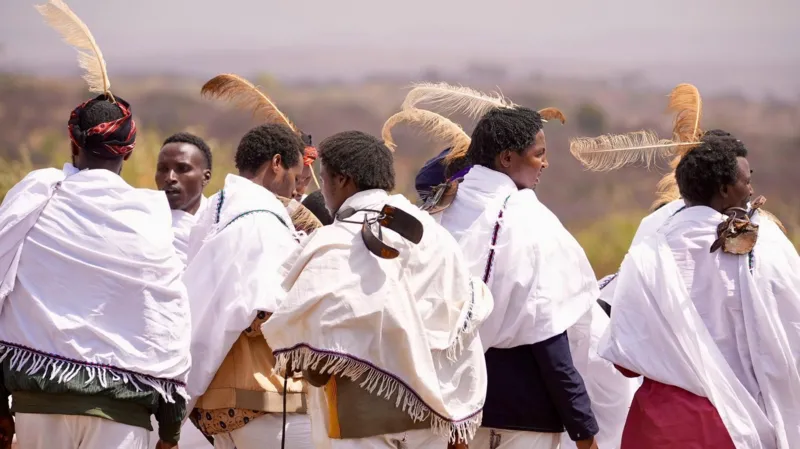
Thousands of people have been gathering in southern Ethiopia for one of the country’s biggest cultural events.
The week-long Gada ceremony, which ended on Sunday, sees the official transfer of power from one customary ruler to his successor – something that happens every eight years.
The tradition of regularly appointing a new Abbaa Gadaa has been practised by the Borana community for centuries – and sees them gather at the rural site of Arda Jila Badhasa, near the Ethiopian town of Arero.
It is a time to celebrate their special form of democracy as well as their cultural heritage, with each age group taking the opportunity to wear their different traditional outfits.
These are paraded the day before the official handover during a procession when married women march with wooden batons, called “siinqee”.
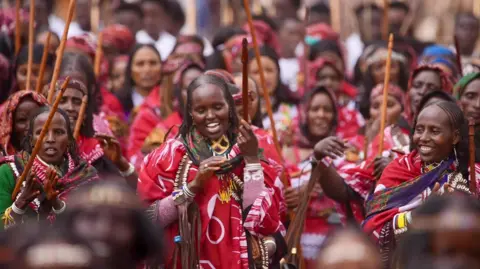
[BBC]
The batons have symbolic values of protection for women, who use them during conflict.
If a siinqee stick is placed on the ground by a married woman between two quarrelling parties, it means the conflict must stop immediately out of respect.
During the procession, younger women lead at the front, distinguished from the married women by the different colour of their clothing.
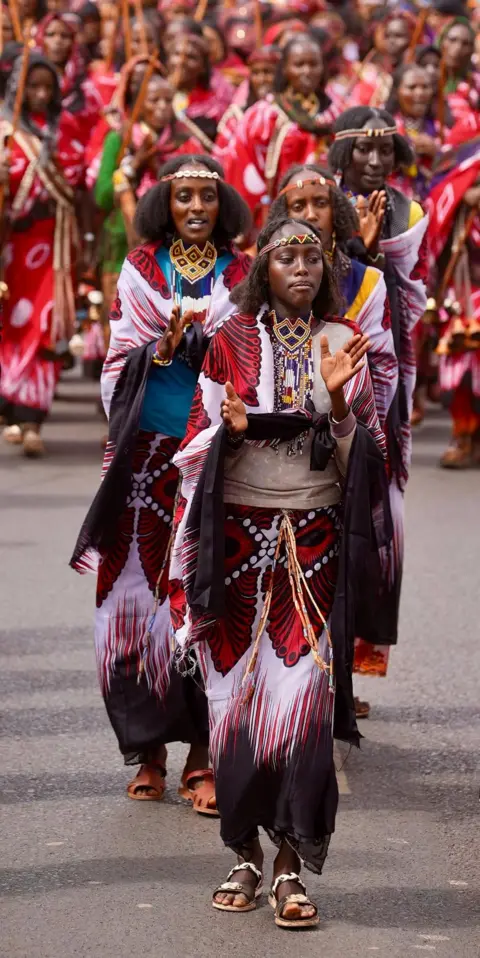
[BBC]
In this pastoralist society women are excluded from holding the top power of Abbaa Gadaa, sitting on the council of elders or being initiated into the system as a child.
But their important role can be seen during the festival as they build all the accommodation for those staying for the week – and prepare all the food.
And the unique Gada system of governance, which was added to the UN’s cultural heritage list in 2016, allows for them to attend regular community meetings and to voice their opinions to the Abbaa Gadaa.
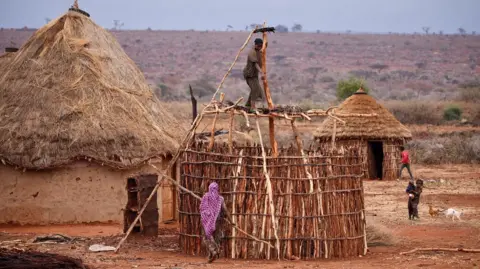
Gada membership is only open to boys whose fathers are already members – young initiates have their heads shaven at the crown to make their rank clear.
The smaller the circle, the older he is.

As the global cultural body UNESCO reports, oral historians teach young initiates about “history, laws, rituals, time reckoning, cosmology, myths, rules of conduct, and the function of the Gada system”.
Training for boys begins as young as eight years old. Later, they will be assessed for their potential as future leaders.
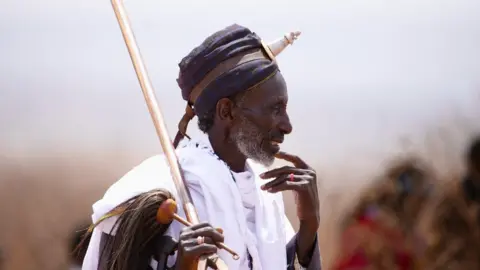
As they grow up, tests include walking long distances barefoot, slaughtering cattle efficiently and showing kindness to fellow initiates.
Headpieces made from cowrie shells are traditionally worn by young trainees. The only other people allowed to wear them are elderly women.
Both groups are revered by Borana community members.
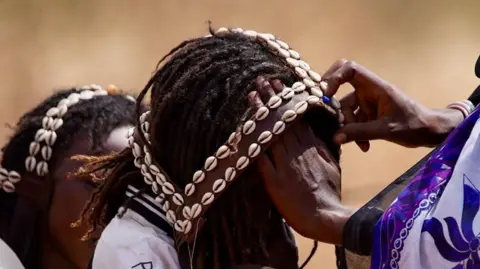
Men aged between 28 and 32 are identified by the ostrich feathers they wear, which are known in the Afaan Oromo language as “baalli”.
Their attendance at the Gada ceremony is an opportunity to learn, prepare and bond as it is already known who the Abbaa Gadaa from this age group will be taking power in 2033.
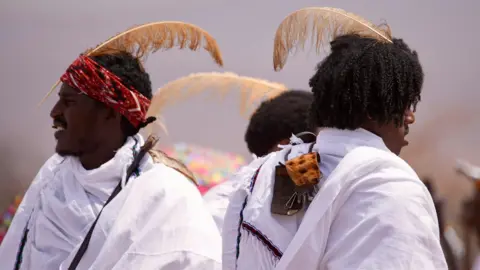
The main event at the recent Gada ceremony was the handover of power, from the outgoing 48-year-old Abbaa Gadaa to his younger successor.
Well-wishers crossed the border from Kenya and others travelled from as far as Ethiopia’s capital, Addis Ababa, to witness the spectacle. The governor of Kenya’s Marsabit county was among the honoured guests.
Thirty-seven-year-old Guyo Boru Guyo, seen here holding a spear, was chosen to lead because he impressed the council of elders during his teenage years.
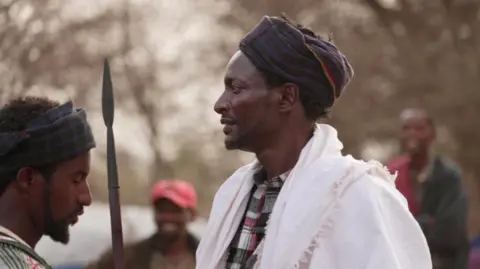
[BBC]
He becomes the 72nd Abbaa Gadaa and will now oversee the Borana community across borders – in southern Ethiopia and north-western Kenya.
As their top diplomat, he will also be responsible for solving feuds that rear their heads for pastoralists. These often involve cattle raiding and disputes over access to water in this drought-prone region.
During his eight years at the helm, his successor will finish his training to take on the job in continuation of this generations-old tradition.
[BBC]
Features
How universities lead transformation in global higher education
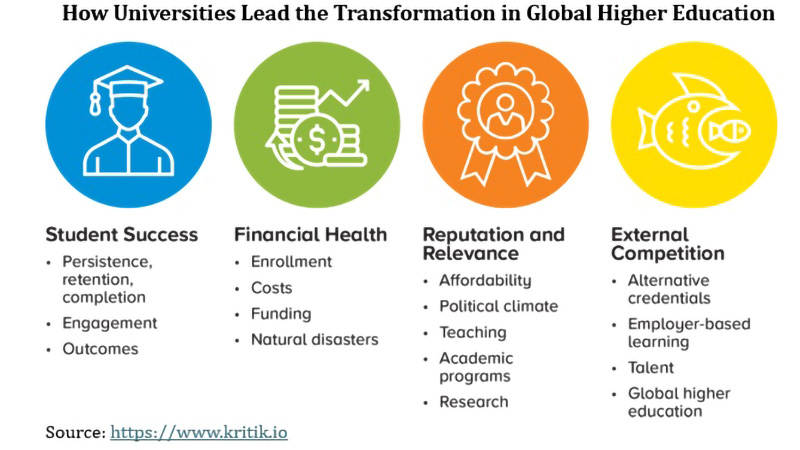
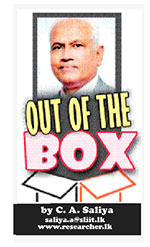 To establish a high-quality educational institution, it is essential to create a sustainable and flexible foundation that meets contemporary educational needs while adapting to future demands. The following outline a robust model for a successful and reputable educational institution. (See Image 1 and Graphs 1 and 2)
To establish a high-quality educational institution, it is essential to create a sustainable and flexible foundation that meets contemporary educational needs while adapting to future demands. The following outline a robust model for a successful and reputable educational institution. (See Image 1 and Graphs 1 and 2)
Faculty Excellence and Research Integration: Recruit faculty members with advanced qualifications, industry experience, and a strong commitment to student development. Integrate research as a cornerstone of teaching to encourage innovation, critical inquiry, and evidence-based learning. Establish dedicated research groups and facilities, fostering a vibrant research culture, led by senior academics, and providing hands-on research experience for students.
Infrastructure and Learning Environment: Develop modern, accessible campuses that accommodate diverse learning needs and provide a conducive environment for academic and extracurricular activities. Invest in state-of-the-art facilities, including libraries, laboratories, collaborative workspaces, and recreational areas to support well-rounded student development. Utilize technology-enhanced classrooms and virtual learning platforms to create dynamic and interactive learning experiences.
Global Partnerships and Multicultural Environment: Promote partnerships with reputable international universities and organizations to provide global exposure and collaborative opportunities. Encourage student and faculty exchange programmes, joint research, and international internships, broadening perspectives and building cross-cultural competencies. Cultivate a multicultural campus environment that embraces diversity and prepares students to thrive in a globalized workforce.
Industry Engagement and Graduate Employability: Collaborate closely with industry partners to ensure that programmes meet professional standards and graduates possess relevant, in-demand skills. Embed practical experiences, such as internships and work placements, within the academic curriculum, to enhance employability. Establish a dedicated career services team to support job placement, career counselling, and networking opportunities, maintaining high graduate employment rates.
Student-Centric Support Systems and Life Skills: Offer comprehensive student support services, including academic advising, mental health resources, and career development programmes. Provide opportunities for students to develop essential life skills such as teamwork, leadership, communication, and resilience. Promote a balanced academic and social life by fostering clubs, sports, and recreational activities that contribute to personal growth and community engagement.
Commitment to Sustainability and Social Responsibility: Integrate sustainability into campus operations and curricula, preparing students to lead in a sustainable future. Encourage social responsibility through community engagement, service-learning projects, and ethical research initiatives. Implement eco-friendly practices across campus, from energy-efficient buildings to waste reduction, promoting environmental awareness.
Governance, Independence, and Financial Sustainability: Establish transparent, ethical governance structures that promote accountability, inclusivity, and long-term planning. Strive for financial independence by building a sustainable revenue model that balances tuition, grants, partnerships, and philanthropic contributions. Prioritize flexibility in governance to adapt quickly to external changes while safeguarding institutional autonomy.
By emphasizing quality, inclusivity, innovation, and adaptability, an educational institution can cultivate a culture of academic excellence and social responsibility, producing well-rounded graduates who are equipped to succeed and contribute meaningfully to society. This framework provides a strategic approach to building an institution that thrives academically, socially, and economically.
Critique of the Traditional Sri Lankan University System
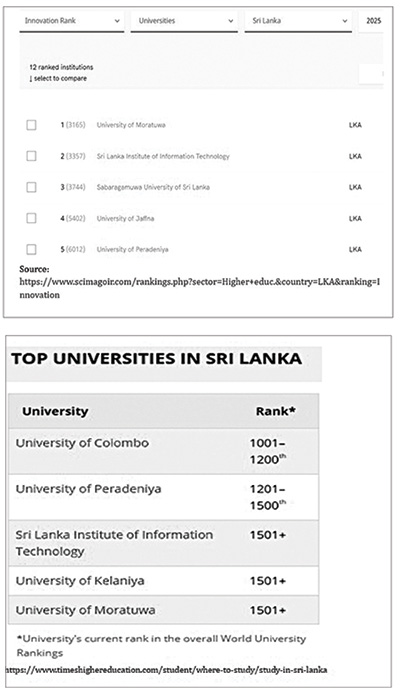 Outdated Curriculum and Lack of Industry Relevance: Many traditional universities in Sri Lanka operate with rigid curricula that are slow to adapt to rapidly changing industry needs, leaving graduates underprepared for the global workforce. Syllabi are often centered around theoretical knowledge with limited focus on practical, hands-on experience, problem-solving, and critical thinking skills.
Outdated Curriculum and Lack of Industry Relevance: Many traditional universities in Sri Lanka operate with rigid curricula that are slow to adapt to rapidly changing industry needs, leaving graduates underprepared for the global workforce. Syllabi are often centered around theoretical knowledge with limited focus on practical, hands-on experience, problem-solving, and critical thinking skills.
Insufficient Research and Innovation Focus: The Sri Lankan university system places minimal emphasis on research, innovation, and practical application, which hinders the development of a strong research culture. Limited funding, resources, and incentives for faculty and students to pursue cutting-edge research reduce international visibility and publications, key factors in global rankings.
Lack of International Partnerships and Exposure: Traditional universities have minimal collaboration with foreign institutions, limiting opportunities for student exchange programmes, collaborative research, and global internships. This lack of exposure restricts students’ cultural awareness, adaptability, and networking skills, which are essential in today’s globalized economy.
Bureaucratic Governance and Inflexibility: Highly centralized and bureaucratic governance structures result in slow decision-making, stifling innovation and responsiveness to changing educational demands. Universities face significant limitations in introducing new programmes, hiring qualified faculty, and allocating resources, which affects their competitive edge and ability to adapt.
Underfunded Infrastructure and Resources: The lack of adequate funding for state-of-the-art infrastructure, technological resources, and modern learning spaces reduces the quality of education and student experience. Insufficient investment in libraries, laboratories, and virtual learning tools limits access to essential resources needed to build research capabilities and attract international students.
Limited Emphasis on Student-Centric Support Services: Support services such as career counselling, academic advising, and mental health resources are insufficiently developed in many institutions, impacting students’ overall well-being and employability. Universities often lack the means to prepare students for the workforce beyond academics, which results in graduates with high academic knowledge but limited job-ready skills.
Recommended Transformations for World-Class Standards
Curriculum Revamp with a Focus on Industry Relevance: Shift towards an interdisciplinary, outcome-based curriculum that aligns with industry requirements and promotes experiential learning. Establish partnerships with industries to incorporate internships, co-ops, and project-based learning, providing students with practical skills. Incorporate modules on critical thinking, problem-solving, and digital literacy, which are essential for employability and adaptability.
Enhancing Research Capacity and Innovation Ecosystem: Allocate dedicated funding for research and establish incentives for faculty and students to publish in high-impact journals. Develop specialized research centres and labs focusing on areas critical to national and global challenges, such as technology, sustainable development, and public health. Foster innovation hubs, incubators, and accelerators, within universities, to support entrepreneurship and collaboration with the private sector, driving societal impact and ranking potential.
International Partnerships and Global Exposure: Form alliances with reputable international universities to offer dual degrees, joint research programmes, and student and faculty exchange opportunities. Encourage academic collaborations that enable students to work on global projects, thereby enhancing cultural competence and preparing them for international careers. Create virtual exchange programmes and international seminars to engage students in global conversations without extensive travel requirements.
Autonomous and Responsive Governance: Decentralize governance to allow universities to make independent decisions on programmes, faculty hiring, and funding allocation, fostering flexibility and responsiveness. Implement performance-based accountability systems for university administrators, rewarding institutions that achieve excellence in teaching, research, and innovation. Empower universities to secure alternate funding sources through grants, industry partnerships, and philanthropic contributions, ensuring financial stability and academic independence.
Investment in Infrastructure and Digital Transformation: Prioritize investment in modern campus facilities, advanced laboratories, and digital learning environments to provide students with a high-quality academic experience. Expand access to online learning resources, digital libraries, and virtual classrooms, offering students a more adaptable, blended learning model. Create dedicated spaces for collaborative learning and interdisciplinary activities, fostering a culture of innovation and teamwork.
Robust Student-Centric Support Systems: Establish comprehensive support services, including career development, mental health resources, and academic advising, to help students navigate both academic and personal challenges. Introduce career-oriented training programmes focusing on employability skills, including communication, networking, and leadership, to prepare students for the workforce. Develop alumni networks and mentorship programmes, connecting students with successful graduates for career guidance and networking opportunities.
Emphasis on Sustainability and Social Responsibility: Embed sustainability principles in campus operations, curricula, and research activities to align with global priorities and contribute to the United Nations Sustainable Development Goals (SDGs). Initiate community engagement programmes that encourage students to apply their knowledge in real-world settings, fostering social responsibility and regional development. Encourage environmental initiatives, like waste reduction, energy efficiency, and green campus policies, reflecting a commitment to global best practices.
By adopting these strategies, traditional Sri Lankan universities can transform into competitive, globally recognized institutions. This shift would enable them to improve international rankings, increase graduate employability, attract a diverse student body, and contribute meaningfully to both the local and global knowledge economies.
The traditional university system in Sri Lanka, while rich in history and academic legacy, faces significant challenges in meeting the demands of the modern, globally connected world. The system requires critical reforms to enhance its alignment with international standards, improve rankings, and produce graduates ready for today’s dynamic job market. This essay discusses the shortcomings of the existing system and provides actionable recommendations to enable Sri Lankan universities to transform into globally competitive, high-ranking institutions.
(The writer, a senior Chartered Accountant and professional banker, is Professor at SLIIT University, Malabe. He is also the author of the “Doing Social Research and Publishing Results”, a Springer publication (Singapore), and “Samaja Gaveshakaya (in Sinhala). The views and opinions expressed in this article are solely those of the author and do not necessarily reflect the official policy or position of the institution he works for. He can be contacted at saliya.a@slit.lk and www.researcher.com)
Features
Govt. needs to explain its slow pace
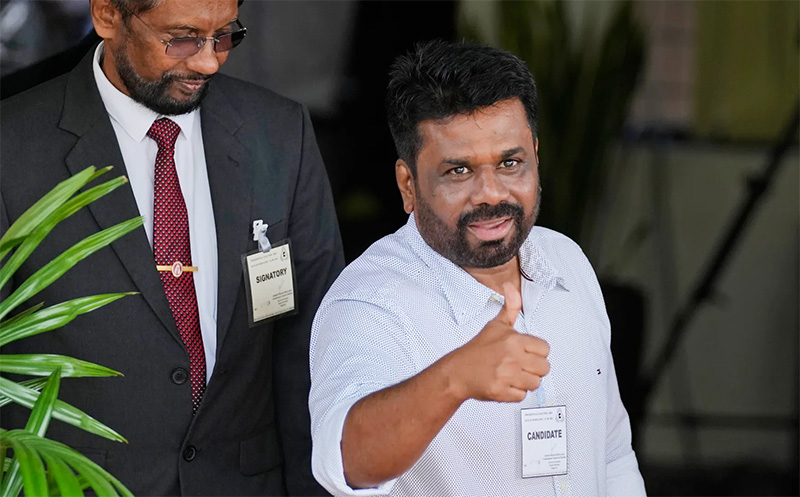
by Jehan Perera
It was three years ago that the Aragalaya people’s movement in Sri Lanka hit the international headlines. The world watched a celebration of democracy on the streets of Colombo as tens of thousands of people of all ages and communities gathered to demand a change of government. The Aragalaya showed that people have the power, and agency, to make governments at the time of elections and also break governments on the streets through non-violent mass protest. This is a very powerful message that other countries in the region, particularly Bangladesh and Pakistan in the South Asian region, have taken to heart from the example of Sri Lanka’s Aragalaya. It calls for adopting ‘systems thinking’ in which there is understanding of the interconnectedness of complex issues and working across different sectors and levels that address root causes rather than just the symptoms.
Democracy means that power is with the people and they do not surrender it to the government to become inert and let the government do as it wants, especially if it is harming the national interest. This also calls for collaboration across sectors, including political parties, businesses, NGOs and community groups, to create a collective effort towards change as it did during the Aragalaya. The government that the Aragalaya protest movement overthrew through street power was one that had been elected by a massive 2/3 majority that was unprecedented in the country under the proportional electoral system. It also had more than three years of its term remaining. But when it became clear that it was jeopardizing the national interest rather than furthering it, and inflicted calamitous economic collapse, the people’s power became unstoppable.
A similar situation arose in Bangladesh, a year ago, when the government of Sheikh Hasina decided to have a quota that favoured her ruling party’s supporters in the provision of scarce government jobs to the people. In the midst of economic hardship, this became a provocation to the people of Bangladesh. They saw the corruption and sense of entitlement in those who were ruling the country, just as the Sri Lankan people had seen in their own country two years earlier. This policy sparked massive student-led protests, with young people taking to the streets to demand equitable opportunities and an end to nepotistic practices. They followed the Sri Lankan example that they had seen on the television and social media to overthrow a government that had won the last election but was not delivering the results it had promised.
CONSTITUTIONAL PROCESS
Despite similarities, there are also major differences between Bangladesh and Sri Lankan uprisings. In Sri Lanka, the protest movement achieved its task with only a minimal loss of life. In Bangladesh, the people mobilized against the government which had become like a dictatorship and which used a high level of violence in trying to suppress the protests. In Sri Lanka, the transition process was the constitutionally mandated one and also took place non-violently. When President Gotabaya Rajapaksa resigned, Prime Minister Ranil Wickremesinghe succeeded him as the acting President, pending a vote in Parliament which he won. President Wickremesinghe selected his Cabinet of Ministers and governed until his presidential term ended. A new President Anura Kumara Dissanayake was elected at the presidential elections which were the most peaceful elections in the country’s history.
In Bangladesh, the fleeing abroad of Prime Minister Hasina was not followed by Parliament electing a new Prime Minister. Instead, the President of Bangladesh Mohammed Shahabuddin appointed an interim government, headed by NGO leader Muhammad Yunus. The question in Bangladesh is how long will this interim government continue to govern the country without elections. The mainstream political parties, including that of the deposed Prime Minister, are calling for early elections. However, the leaders of the protest movement that overthrew the government on the streets and who experienced a high level of violence do not wish elections to be held at this time. They call for a transitional justice process in which the truth of what happened is ascertained and those who used violence against the people are held accountable.
By way of contrast, in Sri Lanka, which went through a legal and constitutional process to achieve its change of government there is little or no demand for transitional justice processes against those who held office at the time of the Aragalaya protests. Even those against whom there are allegations of human rights violations and corruptions are permitted to freely contest the elections. But they were thoroughly defeated and the people elected a new NPP government with a 2/3 majority in Parliament, many of whom are new to politics and have no association with those who governed the country in the past. This is both a strength and a weakness. It is a strength in that the members of the new government are idealistic and sincere in their efforts to improve the life of the people. But their present non-consultative and self-reliant approach can lead to erroneous decisions, such as to centrally appoint a majority of council members, who are of Sinhalese ethnicity, to the Eastern University which has a majority of Tamil faculty and students.
UNRESOLVED PROBLEMS
The problem for the new government is that they inherited a country with massive unresolved problems, including the unresolved ethnic conflict which requires both sensitivity and consultations to resolve. The most pressing problem, by any measure, is the economic problem in which 25 percent of the population have fallen below the poverty line, which is double the percentage that existed three years ago. Despite the appearance of high-end consumer spending, the gap between the rich and poor has increased significantly. The day-to-day life of most people is how to survive economically. The former government put the main burden of repaying the foreign debts and balancing the budget on the poorer sections of the population while sparing those at the upper end, who are expected to be engines of the economy. The new government has to change this inequity but it has little leeway to do so, because the government’s treasury has been emptied by the misdeeds of the past.
Despite having a 2/3 majority in Parliament, the government is hamstrung by its lack of economic resources and the recalcitrance of the prevailing system that continues to be steeped in the ways of the past. President Dissanayake has been forthright about this when he addressed Parliament during the budget debate. He said, “the country has been transformed into a shadow criminal state. While we see a functioning police force, military, political authority and judiciary on the surface, beneath this structure exists an armed underworld with ties to law enforcement, security forces and legal professionals. This shadow state must be dismantled. There are two approaches to dealing with this issue: either aligning with the criminal underworld or decisively eliminating it. Unlike previous administrations, which coexisted with organized crime, the NPP-led government is determined to eradicate it entirely.”
Sri Lanka’s new government has committed to holding local government elections within two months unlike Bangladesh’s protest leaders, who demand that transitional justice and accountability for past crimes take precedence over elections. This decision aligns with constitutional mandates and upholds a Supreme Court ruling that the previous government had ignored. However, holding elections so soon after a major political shift poses risks. The new government has yet to deliver on key promises—bringing economic relief to struggling families and prosecuting those responsible for corruption. It needs to also address burning ethnic and religious grievances, such as the building of Buddhist religious sites where there are no members of that community living there. If voters lose patience, political instability could return. The people need to be farsighted when they make their decision to vote. As citizens they need to recognise that systemic change takes time.
-

 News5 days ago
News5 days agoPrivate tuition, etc., for O/L students suspended until the end of exam
-
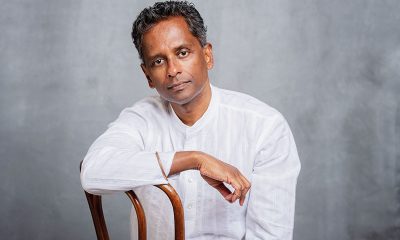
 Features6 days ago
Features6 days agoShyam Selvadurai and his exploration of Yasodhara’s story
-

 Editorial7 days ago
Editorial7 days agoCooking oil frauds
-

 Editorial4 days ago
Editorial4 days agoRanil roasted in London
-
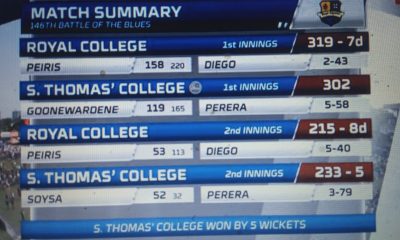
 Latest News4 days ago
Latest News4 days agoS. Thomas’ beat Royal by five wickets in the 146th Battle of the Blues
-
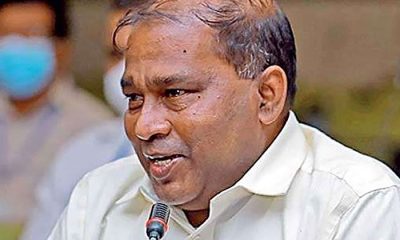
 News5 days ago
News5 days agoTeachers’ union calls for action against late-night WhatsApp homework
-
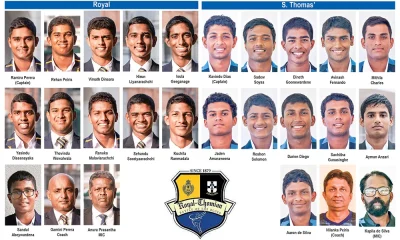
 Sports7 days ago
Sports7 days agoRoyal favourites at the 146th Battle of the Blues
-

 Editorial6 days ago
Editorial6 days agoHeroes and villains











